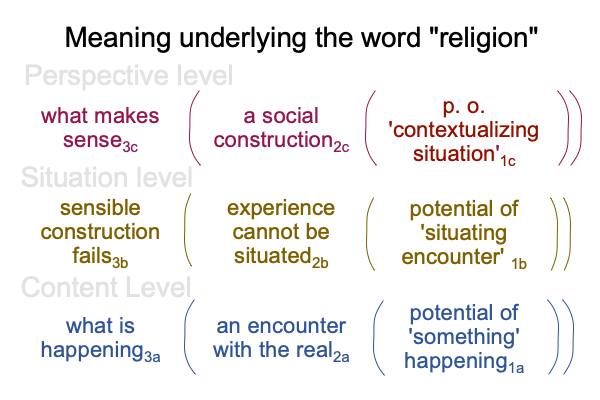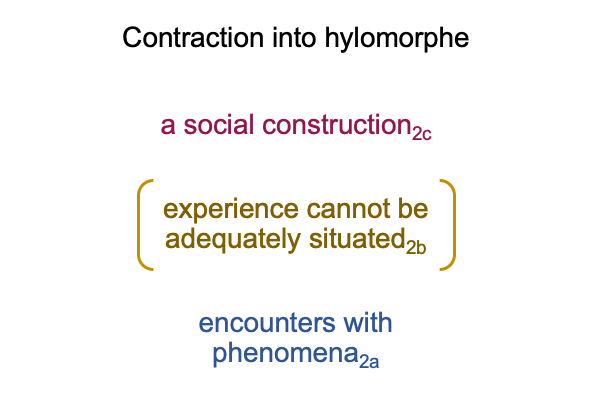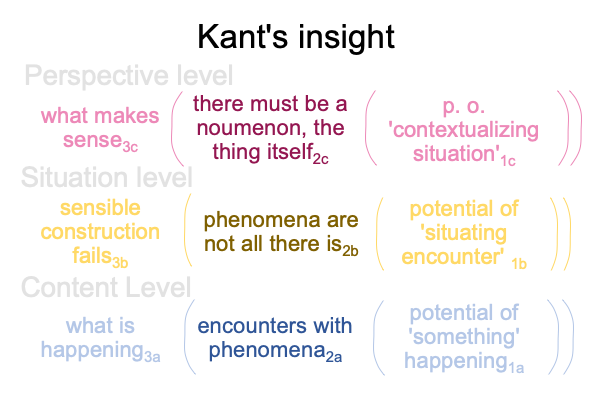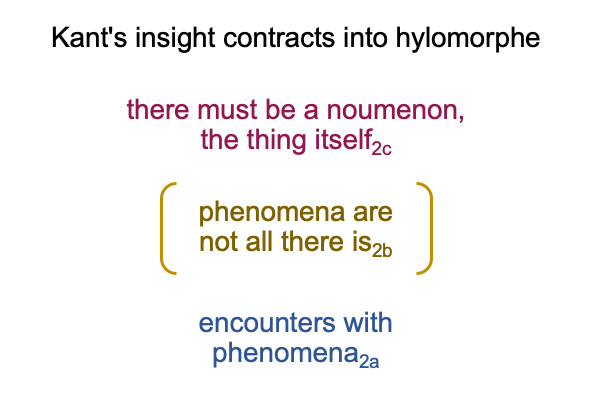0140 What is the meaning, presence and message underlying a spoken word?
That is the question addressed in Razie Mah’s masterwork, How To Define The Word “Religion”, available at smashwords and other e-book venues.
0106 The category-based nested form allows an answer. The normal context of definition3 brings the actuality of a spoken word2 into relation with the potentials of meaning, presence and message1.
0141 How does this answer apply to the topic at hand?
To me, Martin Heidegger (and Charles Peirce, for that matter) wrestle with meaning. Social construction corresponds to the meaning underlying the word, “religion”. Social construction is what happens when one encounters a thing or event that does not make sense. A social construction2c is a perspective-level reference2c constructed on a content-level reference2a.
0142 In addition to How to Define, the following three-level interscope is developed in Comments on Religious Experience (1985) by Wayne Proudfoot.
I start with a content-level category-based nested form. The normal context of what is happening3a brings the actuality of a real encounter2a into relation with the possibilities inherent in ‘something’ happening1a.
Such an encounter would be processed on the situation level within the normal context of sensible construction3b. But, what if sensible construction3b fails? Then the failure of sensible construction3b brings the actuality that the experience cannot be situated2b into relation with the potential of situating the content-level encounter1b.
0143 When sensible construction fails, most people freak out, but not Kant or Peirce or Heidegger or Saussure or other brave souls who wrestle with meaning. They ask themselves, “What makes sense?”, where “sense” means “a recovery from a lack of composure in the face of something that is not experienced as sensible”.
On the perspective level, the normal context of what makes sense3c brings the actuality of a social construction2c into relation with the potential of contextualizing the unsettling situation1c.
0144 Thus, I arrive at a three-level interscope that touches base with the hylomorphic structures introduced earlier in this examination of appendix 2 of Kemple’s book.

The virtual nested form in the realm of actuality contracts into the following hylomorphe.

A key feature of this hylomorphic structure is that the contiguity contains a negation.
0145 So far, so good.
The three-level interscope depicted above describes what Schleiermacher realizes (around 1800 AD) and what Proudfoot tries to dismantle (186 years later) in his rebuttal, entitled Religious Experience.
But, I wonder.
Is Proudfoot arguing against the interscope or the contracted hylomorphic slogan?
Plus… is there a label for a transition from a three-level interscope to a corresponding hylomorphe?
Consolidation? Reduction? Reification?
0146 Does the same whatever this transition is called apply to the slogan attributed to Immanuel Kant (who also wrote around 1800 AD)?
Kant reflects upon the mechanical revolution and the expansion of science. The revolution starts rolling with the mechanical philosophers of the 1600s. The roll is undeniable with mechanization, starting in the 1700s.
Plus, how about those crazy political revolutions in the late 1700s?
Western civilization embraces the empirio-schematic judgment. This judgment contains three elements: well-defined specialized terms, mathematical and mechanical models, and observations and measurements of phenomena. So, everyone (that is, those enjoying the pretensions of science) focuses on phenomena.
0147 But, phenomena alone cannot account for the thing that is being studied!
Kant (more or less) points out that a noumenon (the thing itself) cannot be fully accounted for by its phenomena (that is, the thing’s observable and measurable facets).
0148 Here is a picture of Kant’s insight within the format of this three-level interscope.

0149 Now, over time, this insight, which consists of perspective-level, situation-level and content-level actualities, is taken for more and more for granted. A slogan appears. The slogan expresses a hylomorphic structure, so it is seems like a thing. But, it is not a thing. What is it? A contraction? An idea? Maybe I can call it an “idealism”.

0150 The slogan goes like this, “A noumenon [cannot be objectified as] its phenomena.”
The slogan has the character of a hylomorphic thing that should belong to secondness. But, the positivist intellect regards it as what is and imbues it with firstness. What does the positivist intellect regard as what ought to be and imbue with the category of secondness? What ought to be is the empirio-schematic judgment, where a disciplinary language (relation) brings mathematical and mechanical models (what ought to be) into relation with observations and measurements (what is).
